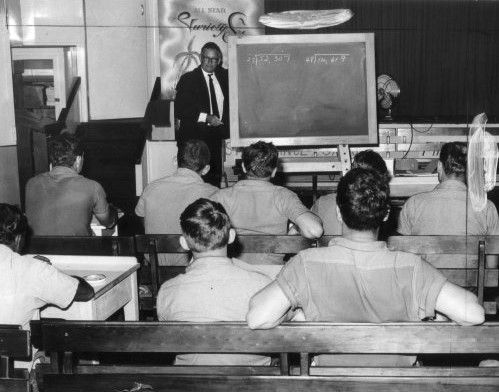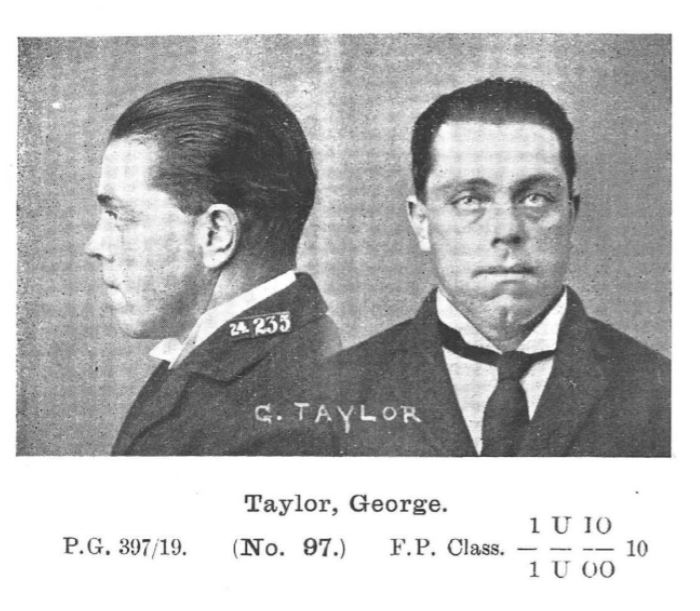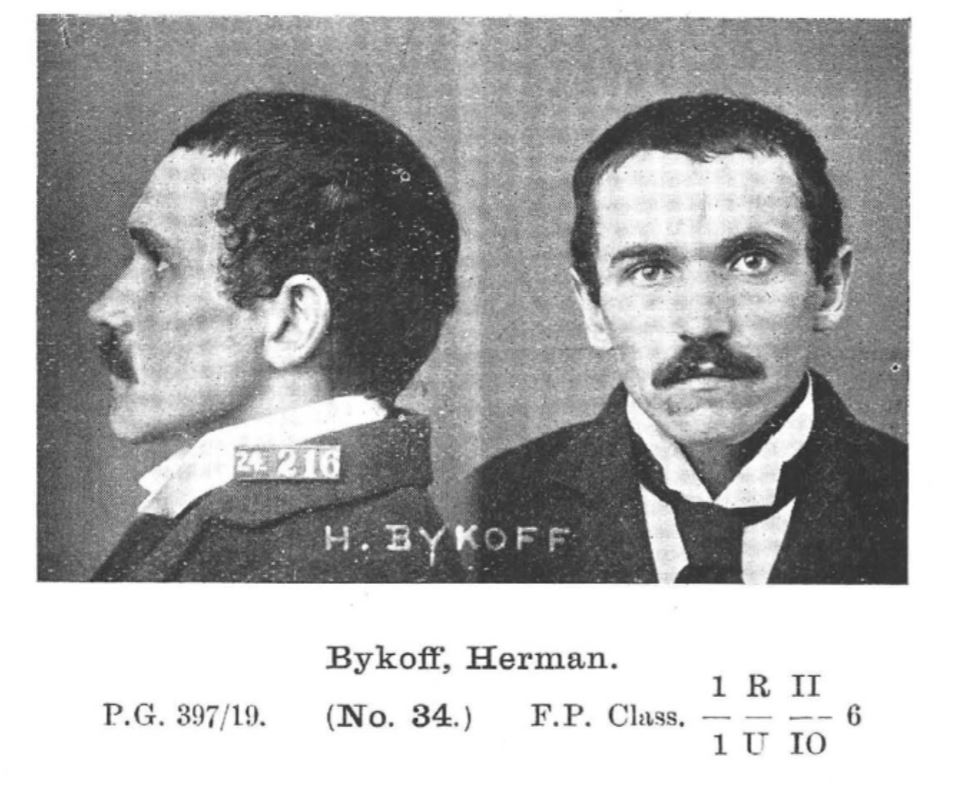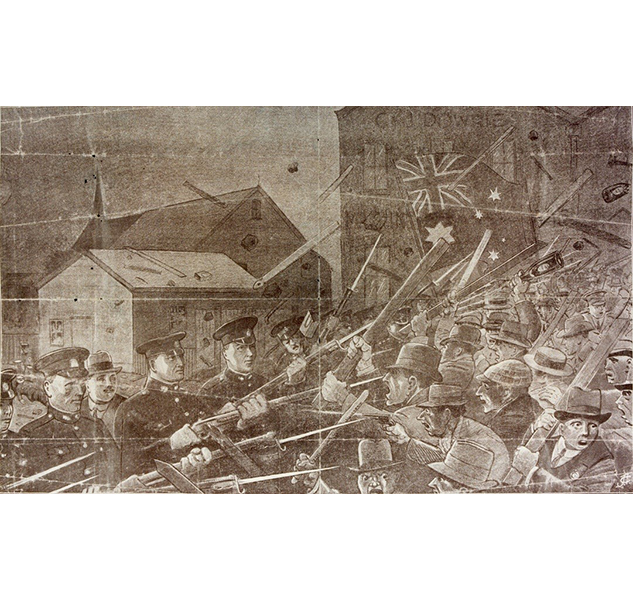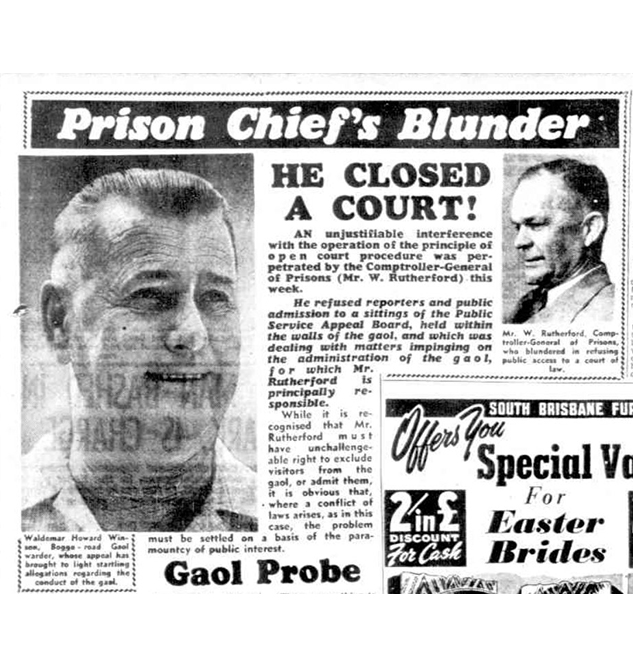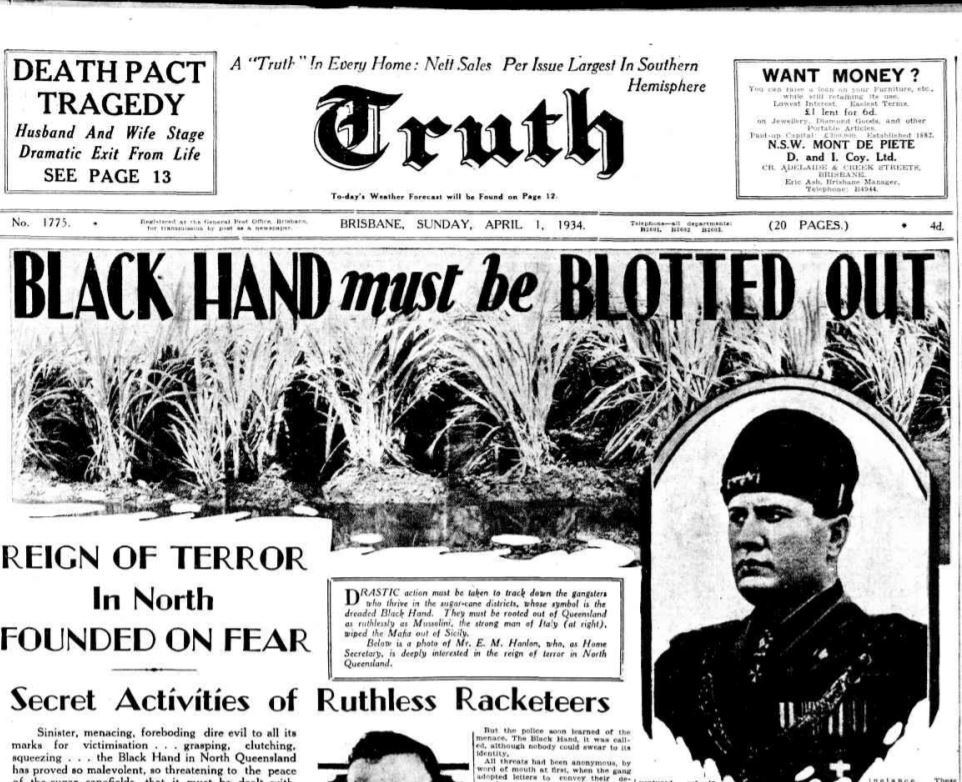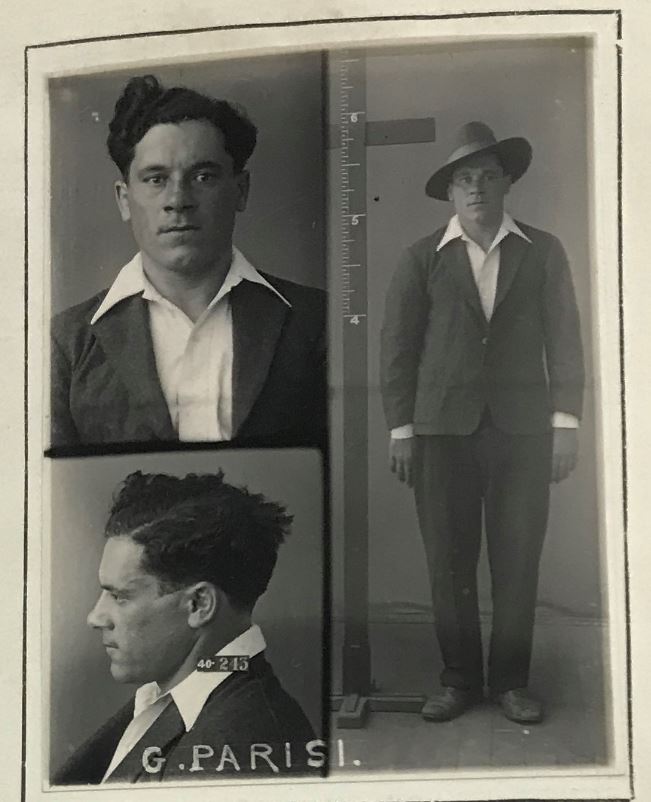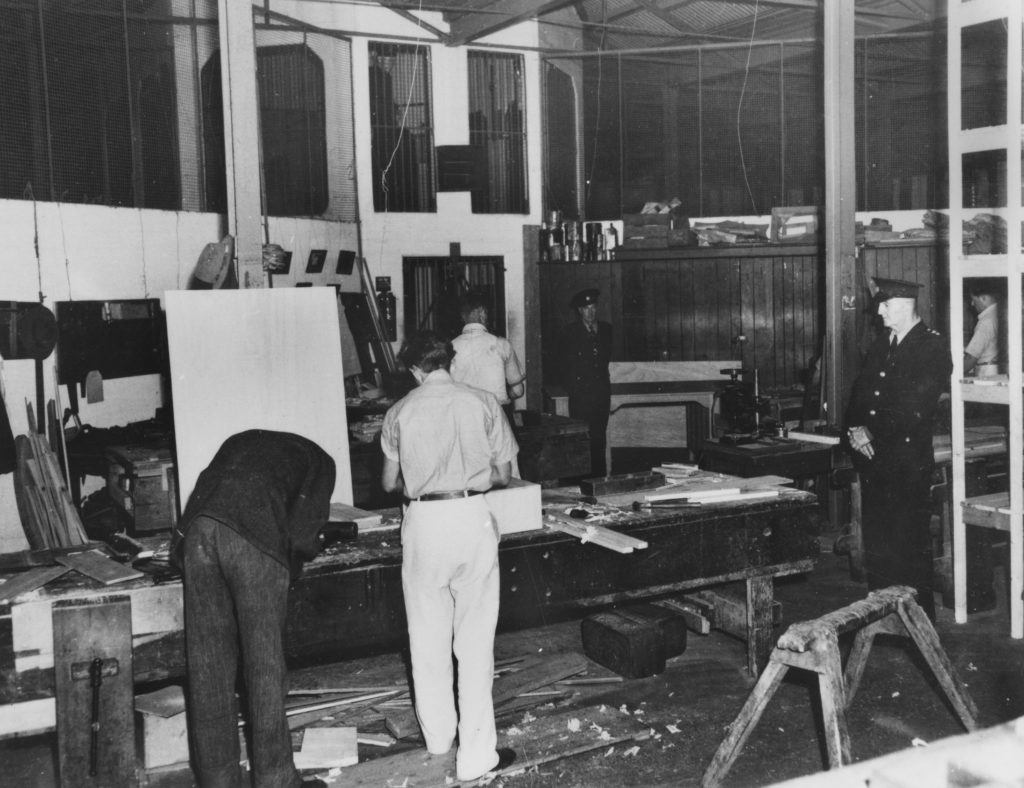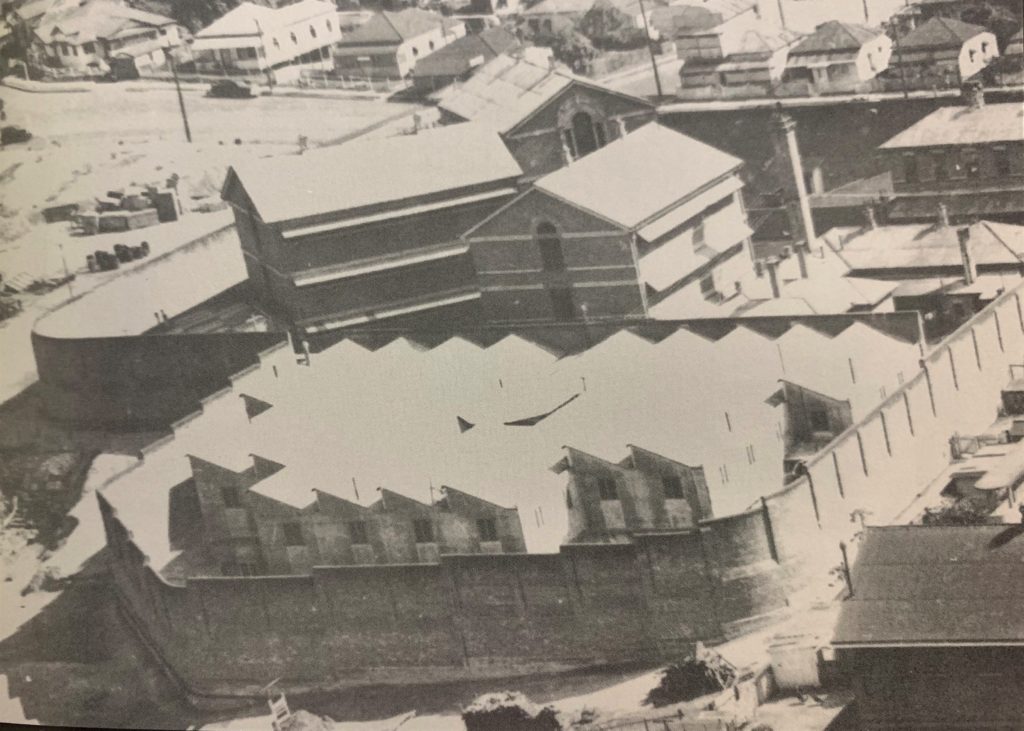From the Headlines -Four More Prisoners Swallow Wire
- On : 16 May, 2019
- By : Boggo Road Gaol
- Category : Stories
- View : 7272
Boggo S2 E 16 – From the Headlines – Four More Prisoners Swallow Wire
Prisoners often cause themselves harm to escape the confines of gaol, if only for a short time. In the 1970s a new era of prisoners were in Boggo Road Gaol, with them came new methods of injuring themselves and others. Gaol Director Jack Sim and Research Coordinator Sue Olsen discuss an important discovery in a 1974 newspaper.
In a remarkable acquisition to our collection. We came across newspapers from the Courier Mail on the last two days in January of 1974. Interestingly, on the front page of the Courier Mail from the 31st of January 1974 there was an article pertaining to Boggo Road Gaol.
4 More Prisoners Swallow Wire
Four young prisoners swallowed wire that was formed into crosses and a fifth prisoner lost his nerve at the last moment and produced his cross to officers.
The crosses were the patented idea of John Andrew Stuart , a lifer, they were made with two sharpened pieces of wire bound with rubber. When swallowed, the crosses would spring open in the stomach and cause incredible pain and often bleeding and necessitate an urgent trip to hospital and the surgical removal of the cross.
It was suspected that a trust prisoner had distributed the crosses to the five prisoners.
Stuart was in the gaol hospital at the time after his fifth operation for the removal of wire crosses from his stomach. Stuart was serving a life sentence for the Whisky Au Go Go Nightclub murder case.
It seems that there was a John Andrew Stuart cult forming in the prison under which these young prisoners formed the misguided views of Stuart. This incident is only one of many.
Flood
At this same time in Brisbane, we were in deep water, quite literally. Christmas 1973 and January 1974 Brisbane had seen weeks of heavy rain. At the time, there was also no Wivanhoe Dam to store the massive amount of water. Consequently, Brisbane was inundated with flood water.
The Prisoners actions by swallowing the wire drew the ire of Mr F. W Gardiner, staunch Labour Party Law reform member. He said, that during a state of emergency these actions took valuable medical resources away that could have been used in flood work.
Flooding brings with it Mosquito born disease and bacterial infections from wading through filthy water. Brisbane was in a serious crisis. There is no doubt the last thing the Brisbane hospital needed was four prisoners intent on harming themselves.
In Season 2 Episode 16 of Boggo – The official Podcast of Boggo Road Gaol, Gaol Director Jack Sim and Research Coordinator Sue Olsen discuss this remarkable find, what was going on at the gaol at the time and what drove the prisoners to such a dramatic action. Listen to the latest episode of Boggo Here
Boggo S2 E15 – Prison Players Male Division
- On : 9 May, 2019
- By : Boggo Road Gaol
- Category : Stories
- View : 3783
BOGGO S2 E15 – Prison Players – Male Division
Gaol Director Jack Sim and Sue Olsen discuss the upcoming launch of the Male Division Prison Players from the 1970s era at Boggo Road Gaol; The important steps being taken in obtaining items to represent prisoners and officers of that time as accurately as possible and some recent acquisitions.
Coming soon to Boggo Road Gaol… the all new Prison Players for the Male Division.
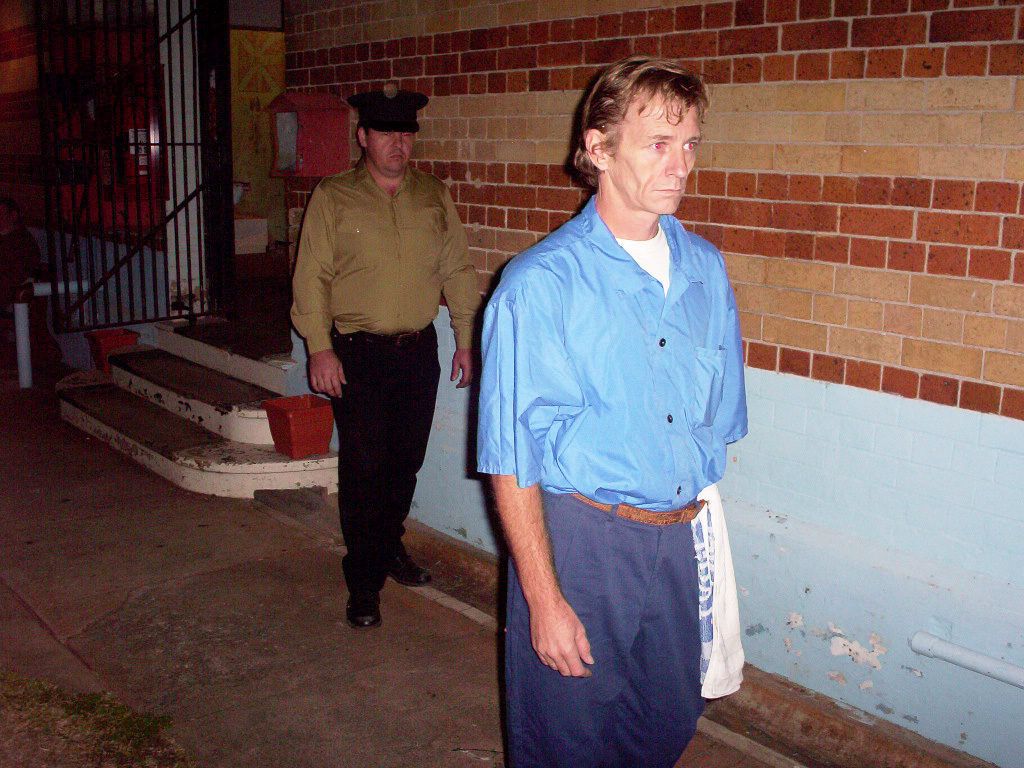
This coming July we have an exciting new addition to the Prison Players, An all new male division experience. This fully interactive experience will delight visitors in a whole new way.
This week on Boggo, Gaol Director Jack Sim and Research Coordinator Sue Olsen discuss the new prison player experience and all of the work that is going into representing officers and prisoners of the 1970’s as accurately as possible.
For more about the new Prison Player experience be sure to tune into our podcast where Gaol Director Jack Sim and Research Coordinator Sue Olsen discuss the launch and how you can be a part of it. Listen now to BOGGO the official podcast of Boggo Road Gaol
Boggo S2 E14 – Our Strangest State School
- On : 2 May, 2019
- By : Boggo Road Gaol
- Category : Stories
- View : 4108
Boggo S2 E14Our Strangest State School
Boggo Road Gaol is hardly a place you could imagine that a State School would be. However, in 1948 that’s exactly where there was one was opened. Under the tutelage of an experienced Brisbane State High School teacher, a school for prisoners was opened inside the walls of Boggo Road Gaol. It schooled all kinds of prisoners… from petty thieves and armed robbers to infamous murderers. Come and visit Our Strangest State School.
School inside gaol was not necessarily a new thing. They had been running education programs inside the walls of the gaol since the early 1930s. However, it had been under a correspondence type basis, or distance education. Never before had there been an official state school set up inside the gaol.
Under the tutelage of Mr George Lockie, an experienced Brisbane State High School teacher – a class of 17 youthful offenders made up the school in 1948. The school was set up to teach the basics, to give prisoners a hand up to move onto a course that will help them obtain meaningful employment upon their release. While at the same time the school also offered the correspondence school which allowed for trade type courses to be completed.
The school was set up in 1948 in the prison chapel/ concert hall, which was located in the original Men’s division or (old number 1 division)
It was certainly no easy task establishing a school inside a gaol. The students were all presented with a questionnaire to ascertain their level of education. Most were at a primary school level of education, while some were at a very limited level and others were at a sub-senior level. The pupils who were all in for crimes ranging from petty theft to armed robbery were divided into grades and were taught at their individual level.
The Truth newspaper reported on the Strangest State School on the 24th of April 1949. Stating that the school had opened in February of 1948. At the time the Truth reporter visited the gaol it had 30 or more students ranging from 18 to 45 years of age. 1949 brought about the program being opened up to men… previously having only been available to youth offenders 18-21, this gave the opportunity for an education to men who still had the chance to start fresh on their release in a new career.
Students were given a canvas satchel and books for their education. The younger pupils being separated into the Debtors Section of Number 2 Division where they sat at school desks and used a slate and chalk. The men being given paper and pencils on which to complete their work.
The school would continue to expand over coming years, having to have a roster system for the use of the classroom. Eventually the school program would be expanded into other prisons in the state commencing with Townsville (Stewarts Creek prison in the early 1950’s.
The program was a great success. With those having completed their courses successfully having a recidivism rate of only 7 in 100 pupils. When the prison farms program commenced the rate was further reduced to 7 in 500. It was clear that this was the way forward.
For more about our Strangest State School be sure to tune into our podcast where Gaol Director Jack Sim and Research Coordinator Sue Olsen discuss education inside Boggo Road Gaol. Listen now to BOGGO the official podcast of Boggo Road Gaol
Boggo S2 E13 – The Colossus of Boggo Road
- On : 25 April, 2019
- By : Boggo Road Gaol
- Category : Stories
- View : 18309
Boggo S 2 E 13 The Colossus of Boggo Road – Nathan Jones
Gold Coast bodybuilder Nathan Jones, at 207 centimeters and weighing 128 kilograms, was nicknamed “The Colossus of Boggo Road” Nathan was convicted in the Brisbane Supreme Court in April 1989 on five counts of attempted robbery and three of the unlawful use of a motor vehicle. In prison, an upset Nathan is said to have torn his cell door off; in reality he was a gentle giant. Having served his sentence Nathan was released and turned his life around eventually becoming a WWE wrestler and later a famous Hollywood movie star.
Nathan Jones is a Queenslander born and bred. Having found himself addicted to Amphetamines and Steroids at a young 18 years old he was committing crimes to feed his habit. Between 1985 and 1987 in both Tasmania and Queensland, Nathan is said to have been part of a series of attempted robberies. Nathan officially became one of Australia’s Most Wanted. Unfortunately for Nathan, is colossus size made him very easy to identify he was captured and he was sentenced to eight years in Boggo Road Gaol. It was later discovered that Nathan had been part of robberies in Tasmania and under appeal by the Attorney General, Nathan’s sentence was increased to 12 years.
In 1989, Boggo Road Gaol had its own troubles. Number 2 Division had been closed… and the prison was at capacity. Nathan however managed to put his head down. He admitted when interviewed by the Courier Mail in 2014 that time in Gaol had taught him many things, he learned to read and write, he also learned sports science and it was in Boggo Road that he began power lifting.
When Boggo Road (then Brisbane Correctional Centre) closed… Nathan was among the prisoners transferred to the new Wacol facilities. Nathan himself admitted ” I was young and stupid and didn’t like the system” when asked about his behaviour inside prison where he allegedly had ripped the door off his cell and had to be restrained by a number of prison officers.
 Powerlifting and Strongman Career
Powerlifting and Strongman Career
As we know, Nathan began his power lifting career inside prison. However when he was released in 1994, Nathan began his rise in the circuit to become National Power lifting champion of Australia just a few months later. From there it was onward to Australia’s Strongest Man. He would go on to compete in the World Strength Championship in Scotland as part of the highland games which he would win topping the field against a strong competition including 1993 Worlds Strongest Man Gary Taylor. He would compete in the Worlds Strongest Man Competition in 1995, in the second round of the arm wrestling competition Nathan Jones would spiral fracture his arm while competing against giant Magnus Samuelsson (eventual 1998 World Strongest Man) putting him out of the competition. He would return the following year however to finish third.
Wrestling Career
After working as a bodyguard for multimillionaire Rene Rivkin, Jones began a career in wrestling during this time. Jones first gained fame working in World Wrestling All-Stars, making a large impression at the first WWA pay-per-view “Inception”, where he was accompanied to the ring by Rove McManus. However he was defeated after Rove was smashed with Jeff Jarrett’s guitar and Jones was hit with the Stroke.
During his time in the WWA, Nathan won the WWA World Heavyweight Championship on 7 April 2002 before losing the belt to Scott Steiner only 5 days later. After the title loss, Jones began performing for Pro Wrestling Zero1-Max in June 2002.
World Wrestling Entertainment (2002–2003)
After Nathan initially signed his contract with World Wrestling Entertainment (WWE), he was unable to work in the United States because of visa issues stemming from his criminal history. In late 2002 and early 2003, Jones began performing in dark matches (non televised) for World Wrestling Entertainment. He was originally promoted as a “Hannibal Lecter” type character.On the April 10, 2003 episode of SmackDown!, Nathan made his televised WWE in-ring debut and defeated Bill DeMott.
Upon debuting, Nathan’s original character was nixed, and he was put into a story line with The Undertaker as his protégé and helper during Undertaker’s feud with A-Train and The Big Show. At WrestleMania XIX, Jones and Undertaker were scheduled to face Big Show and A-Train in a tag team match, but at the last minute, the match was made a handicap match instead.On screen, Nathan was attacked prematch and left injured. Near the closing moments of the match, Nathan reappeared and attacked Big Show, enabling Undertaker to pin A-Train for the victory. Nathan was then sent to Ohio Valley Wrestling to improve his skills.
Nathan was then absent from television for several months until returning in the Autumn of 2003 as a villain known by the nickname “The Colossus of Boggo Road”, a title referring to his time spent in Boggo Road Gaol. He was paired with Paul Heyman on-screen and Heyman was given the role as Smackdown General Manager. He was also immediately placed into Brock Lesnar’s Survivor Series team, which also included A-Train, Big Show, and Matt Morgan in order to compete against Lesnar’s rival Kurt Angle and his team. At Survivor Series, Jones was eliminated by Angle after he submitted to the Ankle lock. Team Lesnar was defeated by Team Angle and Jones was then relegated to interfere in Lesnar’s matches along with the other members of Team Lesnar. He was also placed in matches by either Lesnar or Heyman to aid them. On 6 December 2003, Nathan quit the company due to the rigor of WWE’s heavy travel schedules while on tour in Perth, Australia.
Post-WWE and retirement
After leaving WWE, Nathan was to attempt a couple of come-backs into wrestling but never did. His wrestling career was officially over. However, it was all really just beginning for Nathan. His time in the WWE and his skills in acting lead him in good stead. Being seen by none other than Jacki Chan…. in 1996 Nathan appeared in his first movie with none other than Jacki Chan himself. It was Nathan’s real big break. Making numerous movies… Nathan was quickly becoming a Hollywood movie star.
The reader would probably recognise Nathan in some of his movie roles. He played opposite Brad Pitt in Troy as Boagrius, in 2007 he returned to Boggo Road Gaol to film The Condemned starring Vinnie Jones and Wrestling buddy Stone Cold Steve Austin. Nathan appeared in Australian Horror film Charlies Farm and also with Tom Hardy and Charlize Theron in Mad Max – Fury Road as Rictus Erectus.
Nathan has moved far away from his days as a prisoner inside the walls of Boggo Road Gaol. Having a successful career and now a partner and family, he resides in south east Asia. He does however make regular visits back to Australia to play roles in movies and to visit events such as Gold Coast Supanova comi con and gaming.
For more about Nathan Jones the Colossus of Boggo Road Gaol be sure to tune into our podcast Gaol Director Jack Sim and Research Coordinator Sue Olsen discuss Nathan’s fascinating career. BOGGO the official podcast of Boggo Road Gaol.
Boggo S2 E12 – Red Flag Protests
- On : 18 April, 2019
- By : Boggo Road Gaol
- Category : Stories
- View : 3402
Boggo S2 E12 – Red Flag Protests
A century ago this month, one of the most violent political protests, indeed probably the first real protest of its kind – marched its way through the streets of Brisbane City. What would ensue over the coming days would change Brisbane forever. It would also see thirteen men locked up in Boggo Road Gaol for long sentences with hard labour.
Australia had been at war for the preceding five years. It was 1919 the end of the First World War, a bloody and terrible series of campaigns. The war was over and the soldiers had returned, all of them changed forever. We had changed forever. The politics of war was not over, however, this was the era that real freedom of speech and beliefs would begin. This political belief system would also turn horribly violent. This is the first time in Queensland’s history we had ever seen something like this…. but lets step back a little bit.
The root of the protests that would happen in the coming days in March of 1919 would be the War Precautions Act of 1914.
War Precautions Act 1914
The War Precautions act is described as – An Act to enable the Governor-General to make Regulations and Orders for the safety of the Commonwealth during the present state of war.
The Act would cover all types of regulations governing the use of transportation, lighting and even homing pigeons right through to the sinister type things like trespassing, spreading reports that might misinform or cause alarm or being a sympathizer to any enemy of the Commonwealth.
In Brisbane, there was a large group of Bolshevik nationalists, not intentionally violent by any means however very political in nature. It is this group of people that through the right to peaceful protest would be the commencement of an all out war for Brisbane over the next few days.
The Red Flag Procession
The Bolshevik community in Brisbane had requested permission to peacefully march through the streets of Brisbane to the Domain to hold a public meeting in protest against the continuance of the War Precautions Act despite war being over. The permission had been granted on the condition that (as the War Precautions Act Prohibited) no red flags or other political items be displayed. The conditions were agreed upon and on the afternoon of the 23rd of March the procession would leave from Trades Hall in Turbot Street and weave its way through the streets of Brisbane to the Domain, adjacent to the Botanical Gardens and the Parliamentary Buildings.
However, At around 2pm hundreds of men, women and children formed a procession with the children and women taking the lead. All members of the procession war something red. A red handkerchief, a sash, red ties and pieces of ribbon. Some members of the procession defiantly carried huge red flags.
The Evening Telegraph newspaper in Charters Towers shared the most comprehensive view of the drama. We publish here exactly as it was written.
RED FLAG PROCESSION
Evening Telegraph (Charters Towers, Qld. : 1901 – 1921), Monday 24 March 1919, page 3
Telegrams.
BOLSHEVIK RUMPUS IN BRISBANE. RUSSIAN RED FLAG PROCESSIONISTS.
CONFLICT WITH THE POLICE. ACTING PREMIER DECLINES TO COMMENT.
BRISBANE, Sunday.
Brisbane’s Bolsheviks were seen in their true colours yesterday. They attacked the police with sticks and stones and- forcibly carried the Red Flag through the city streets to the Domain, whore they held a demonstration and congratulated themselves upon the success of the proceedings. Between two o’clock and half-past two, men, women and children assembled in largo numbers to take part in a protest meeting against the continuance of the War Precautions Act.
They wore red ties, pieces of red ribbon in the laps of their coats, and red sashes and dresses, whilst some of the more venturesome carried red flags. Mr Wright, President of the Brisbane Industrial Council, urged the processionists not to display the Red Flag, His advice was unheeded. The parade eventually formed up and was about to move off to the Domain. The women and children were in the lead followed by Russians, the majority of whom wore armed with huge red flags attached to stout poles. As the procession was about to move off Sub-Inspector Brosnan stood in front and, addressing the women said, “Wo will not allow the procession to proceed unless these red flags are put away.” It looked probable that the procession would prove a “wash out’ “Then the police called upon the Russians to surrender their flags. The singing, of -‘L’Internationale” started the march .to the Domain. Sub-Inspector Brosnan made a grab at a red flag carried by a- powerful looking Russian, and a fierce struggle ensued till the officer was overpowered by weight of numbers. Sub-Inspector McNeill, Acting-Sergeant Coman, Davis and four constables attempted at’ other parts of the procession to disarm men who carried rod flags, but the eight officers ‘and men were no match for 300 to 400 able bodied processionists, who burled their weight at the. police whenever they made a stand. At the corner of Ann Street and Edward ‘Street Sub-Inspector Brosnan was ahead of the procession end Troopers F. Harris,’ C. Bateman, W. Aspinall and W Wighton, who were waiting for the ‘”call on the part of the police, attempted to bring the procession to a halt by extending themselves on the road and, facing the mob. The- Russians,” however, used their red -flags attached to long poles to such- ‘effect that the horses would not stand -‘-The.’ troopers formed up again and charged the mob, but were again ‘beaten back. The Russians struck them with’ great force upon the wrists, and ‘-belaboured the horses about the head. ‘.’All the time the processionists were singing, shouting, jeering at the police, and waving their flags. Turning, into Queen Street at the head of. the procession, the troopers made a number of dashes into the crowd,’ and It looked for a moment as If they had succeeded in holding the mob. A particularly heavy rush on the part of the Russians, and others, who were being strengthened all along the route convinced the Police that they had no chance of making a fight of it. However, they stuck to their work and attacked the body of the procession, while, the troopers made charge after charge. Some of those marching evidently expected that the police would attempt to intervene, and in their pockets, they had a supply of stones which they used with deadly effect on the haunches of the horses. One trooper received such a heavy blow on the wrist that he was forced to ride with one hand on the reins, and at the same time urge his mount to ride at the red flags and the howling mob. The Russians seemed more pleased the nearer they got to the Domain. Through George Street they picked up a number of reinforcements who awaited them. They were overjoyed when they witnessed the success their main body had achieved and did not hesitate to say so. They added to the chorus by singing “Solidarity” and “If over. I be a soldier.” The acting Premier, Mr Theodore, last night declined to make any comment on the disturbance. The Police Commissioner Is also reticent.
The day was only just beginning. Returned Diggers were most displeased with the protest in the first place and on hearing of the trouble they too took to the streets. By the time the procession had reached the gates of the Domain there were the protesters on one side, the diggers on the other and the police attempting to keep order in the middle. The gates of the Domain having been locked to prevent the protesters gaining access caused even more problems, before eventually the decision was made to allow the protest and meeting to happen.
The Diggers, however, decided to take matters into their own hands. A shout of “Lets Raid the Bolsheviks headquarters” saw a group of diggers form up and march across Victoria bridge toward the headquarters. However, they were quickly discouraged when shots were fired from inside the building of the Bolshevik Headquarters in Merivale Street, South Brisbane.
At the end of Day one… we saw Thirteen Protestors in Boggo Road Gaol.
Thirteen Protestors in Boggo Road Gaol.
Thirteen members of the procession were taken into custody and lodged in Boggo Road Gaol for a period of 6 months. These prisoners included returned Australian serviceman and Bolshevik Russians alike. Some of these we are fortunate to have found images of.
Day two – The Battle for Merivale Street
From the diary of Constable O’Driscoll we read what happens next.
The following day rumours began to circulate of a plan to set the Russian Hall on fire. In the evening up to 8,000 men, some armed, assembled on Merivale Street and within an hour, a fierce battle started between ex-soldiers and police, with Constable Mick O’Driscoll once again was in the thick of the onslaught:
At about 7pm a strong force of police, with rifles and fixed bayonets, marched into Merivale Street, and was disposed in two lines stretching across the street and about 100 yards apart. Drawn up in the rectangle behind their armed colleagues were hundreds of police armed with batons, whilst a strong detachment of mounted police were stationed in Russell Street, close by. Sounds of soldiers singing “keep the home fires burning” and “Australia will be there” reached us in the rectangle. The air was tense and electric as the 50 odd men in blue came to the “on guard” position facing the soldiers now advancing towards them at the double. The diggers came on purposely, pausing only when they came in contact with the cold steel. The pressure from the crowd behind steadily mounted and eventually a concerted rush forced their leaders on to the points of the bayonets. Meanwhile a section of the mob, armed with palings and scrap iron, tried to infiltrate around the front lines of police, but were repulsed by the police armed with batons. The men in the ranks were receiving frequent injuries and the police casualties were mounting. Excitement and feeling became intense throughout the fighting, and many policemen were noticed with blood flowing down their faces.
The battle raged for two hours. Commissioner Urquart was stabbed in the right shoulder with a bayonet, but returned to the scene after his wound was dressed at the Mater Hospital. Sub-Inspector McNeill was hit in the forehead with an iron bar, Sergeant Ferguson sustained a fracture to the skull, mounted Senior Constable Bell had a broken rib, Constables Bateman and Byrne received bullet wounds to the arm and body. Plain-clothes Constable O’Driscoll was struck in the knee with a bottle. A total of 22 policemen and two civilians were listed as injured in the struggle.
This image was extracted from the Queensland Police Journal June 11 1919.
We would like to acknowledge the assistance of the Queensland Police Museum in researching and publishing this story.
In this episode of BOGGO, Gaol Director Jack Sim and Research Co-Ordinator discuss the protests, the Battle for Merivale street and much more about this story. Tune in to BOGGO the official podcast of Boggo Road Gaol to hear more.
You can stand in the spaces that these political prisoners were held every day on our History Tour for tour times and prices visit www.boggoroadgaol.com
Boggo S2 E11 – The Secret Inquiry
- On : 11 April, 2019
- By : Boggo Road Gaol
- Category : Stories
- View : 3453
BOGGO S2 E11 – The Secret Inquiry
In the 1950s conditions at Boggo Road Gaol were at fever pitch. The prison was horribly over-crowded, prisoners and officers were unhappy. There were riots, protests and regular violence. Finally, late one night there was an escape attempt by notorious violent offenders. This attempt and one officers firm stance would be the subject of a secret inquiry held within the walls of Boggo Road Gaol.
The Attempt
In October 1953, Boggo Road Gaol was at capacity, in fact, it was well over capacity. During the preceeding month… there were up to 60 extra prisoners being held in Boggo Road Gaol. These prisoners were being locked in less secure buildings and even left out of cells and secured in a block.
Two young prisoners were among 20 prisoners that were loose in number 1 division Boggo Road Gaol in the A Wing Cell block. The cells on the three tiers of the block already being occupied the officers had no choice but to simply secure the extra inmates in the block… the prisoners sleeping on the floor in the hallways.
These two prisoners took advantage of this freedom by breaking through a lattice door in the cellblock and escaping into Number 2 yard. It was just as they were climbing over a picket fence into the track that they were seen by guards and rounded up using fire hoses.
The Punishment
In the inquiry to follow, the prisoners were punished with an additional month on their sentence for attempted escape. The officer however would be the subject of a major inquiry. Ultimately it would be decided that he would be allowed to remain in the job, however, his pay would be cut significantly from £702-10 a year to £687-10 a year.
The Inquiry
The officer, Waldemar Howard Winsen admitted that he had left his post to go to the kitchen to stoke the fire, and later to the woodyard to obtain more wood before returning to his post.
However, when his Barrister Mr William Boden stated that he was in possession of orders that the officers were required to stoke the fire in the kitchen at night and that since then a memorandum changing these orders. Also that the prison was extensively overcrowded and that the officers lives were in danger. Comptroller General of Prisons Mr Rutherford demanded that the setting for the inquiry be removed from the Public court of Petty sessions to the security of Boggo Road Gaol. Of course, He was in control of the prison, therefore no public or press would be permitted.
The inquiry would then become secret and held behind prison walls. Of course, there would also then be no public record of anything that is said in the inquiry.
The public smelling a cover up… would complain extensively. Eventually, some two weeks later, a secondary inquiry would be held again in the court of petty sessions. However, none of the evidence that was obtained from the secret inquiry would be shared in court. It was dodgy from the start.
The Outcome
There was however a significant outcome from this escape attempt and the secret inquiry that followed. The results would affect Boggo Road Gaol forever.
To find out more listen to BOGGO the official podcast of Boggo Road Gaol. Gaol Director Jack Sim and Research Coordinator discuss the inquiry in full and its outcome.
BOGGO S2 E10 – The Black Hand
- On : 4 April, 2019
- By : Boggo Road Gaol
- Category : Stories
- View : 8702
Boggo S2 E10 – The Black Hand
Mafia activity has been known to exist in Australia’s southern states for decades. Many however would not know that in the 1920s and 1930s Queensland had its very own Mafia. Known as the Black Hand they were every bit as dangerous as their southern counterparts. This group of migrant Italian cane field workers was full of extortionists, thieves, pimps, rapists and cold-blooded murderers. Four of these men would end up in Boggo Road Gaol.
Mafia activity has been known to exist in Australia’s southern states for decades. Many however would not know that in the 1920s and 1930s Queensland had its very own Mafia. Known as the Black Hand they were every bit as dangerous as their southern counterparts. This group of migrant Italian cane field workers was full of extortionists, thieves, pimps, rapists and cold-blooded murderers. Four of these men would end up in Boggo Road Gaol.
Black Hand in Queensland
During the 1920’s, Australia’s sugar cane plantations attracted a steady supply of labourers, many willing to work for lower scale wages. As such, the northeast Australian state of Queensland attracted large numbers of migrant workers. Alongside numerous other ethnic groups, Italian families settled in the coastal towns of Cairns, Townsville and Brisbane, and in particular, the inland towns such as Ayr, Ingham and Innisfail where the work was plentiful.
The Black Hand operated on a simple method of extortion. It would loan a person money… usually the poorest people…. And when they couldn’t pay the unreasonable percentage… threats were made and when they still couldn’t pay violent retribution would take place. It was a terrible business but one that the Black Hand utilised very well. Making the members very wealthy, but also making them targets for retribution by other members of the hand as well.
Known Members of the Black Hand
BOSS – Vincenzo D’Agostino
SOTTO CAPO ( Right Hand) Francesco Femio alias Antonio Arena
LIEUTENANTS – Domenico Belle, Domenico Strano and Giuseppe Mammone
Known Crew or suspected crew.
Giovanni Delfino
Domenico Scarcella
Saverio Militano
Antonio Spiallia
Antonio Cavallo
Ferdinand Legazzo
Vincenzo Speranzo
Mario Strano
Lorenzo Zucco
Giuseppe Parisi
Giuseppe Buetti
Giovanni Iacona.
Todays podcast story is a tale of retribution with a horribly bloody result. The last four members of the list, Zucco, Parisi, Buetti and Iacona are four men who through their involvement in the Black Hand would spend time in Boggo Road Gaol.
Here is the interesting case of Innisfail farmer Giuseppe Iacona. Following arguments regarding Black Hand letters delivered by Iacona to Patane and another farmer named Orario Denaro, on behalf of Lorenzo Zucco: – a notorious extortionist, blackmail artist and standover man in Cairns. Zucco was trying to make a name for himself, attempting to rise through the ranks into the leadership of the Hand.
Iacona was visited by three members of the gang, who arrived at his property on the 11th of February 1934. Following an altercation and subsequent scuffle, Giuseppe Parisi and Giuseppe Buetti held Iacona down while Giuseppe Mammone cut off the man’s ears. Recuperating in hospital over the next three weeks, Iacona refused numerous requests to name his attackers, and the reasoning behind his non-cooperation would soon become clear.
Upon his release from the hospital, Iacona returned to his home and retrieved his shotgun. He confronted Mammone in the main street of Innisfail, and shot dead Mammone – the man who had mutilated him. Duly arrested for the revenge-murder, Iacona came clean on everything and named Parisi and Buetti as having also been involved, as he described the attack and his mutilation in court. Iacona received a life sentence for the murder of Mammone.
In the same court on the same day as the murder trial against Iacona was presented four men – Patane, Denaro, Parisi and Buete were brought to court with having done grievous bodily harm to Giovanni Iacona.
Patane and Denaro were found not to have a case to answer… how… we don’t know – while Parisi and Buetti received seven years each for the unlawful wounding of Iacona. All three men – Iacona, Parisi and Buetti would be locked up in Boggo Road Gaol for the duration of their sentence. All of them – Likely in number 2 division due to the seriousness of their crimes.
Interestingly, Lorenzo Zucco would also be arrested. Earlier in that day again in the same court, Patane and Denaro appeared as witnesses against Lorenzo Zucco, the extortionist and stand over man from Cairns who had written the letters that started this whole mess in the first place! Zucco – found guilty – would be sentenced to seven years with Hard Labour in April of 1934 for crimes involving blackmail and threatening with violence. He too would arrive in Boggo Road Gaol for his sentence…. Also in number 2 division. One can only imagine how tense in could have been for the prison officers at the time.
Iacona denied being a part of the Black Hand and sending threats to other Italians, that he was a hard working battler. However research has proven otherwise. Mammone had been asked by Di’Agistino to intervene in the situation… Perhaps it was a message to Iacona to tow the line.. or perhaps it was a message to Zucco to keep off their turf. Either way, it was ineffective and Mammone would be the ultimate victim.
The “Victim”

This photograph was one of a collection exhibited at City of Shadows an exhibition by the Justice and Police Museum in Sydney between 2005 and 2007.
Curator Peter Doyle suggests that, compared with the subjects of prison mug shots, “the subjects of the Special Photographs seem to have been allowed – perhaps invited – to position and compose themselves for the camera as they liked. Their photographic identity thus seems constructed out of a potent alchemy of inborn disposition, personal history, learned habits and idiosyncrasies, chosen personal style (haircut, clothing, accessories) and physical characteristics.”
Special Photograph no. 1916. Although labelled ‘G Mammona’, the mug shot shows Giuseppe Mammone, who was presumably interviewed and photographed in connection with the stabbing murder of Domenico Belle on Newtown Station, on the morning of 11 February 1930.
Earlier that day Belle had attempted to collect a debt of 15 pounds from Mammone, who ran a barbershop in Leichhardt. It was revealed at the coronial enquiry that Mammone had previously served time in Buffalo, New York, for manslaughter. Newspaper stories of the time repeatedly refer to Mammone as the main suspect in the case, although he was not charged.
This picture is one of a series of around 2500 “special photographs” taken by New South Wales Police Department photographers between 1910 and 1930. These “special photographs” were mostly taken in the cells at the Central Police Station, Sydney and are, as curator Peter Doyle explains, of “men and women recently plucked from the street, often still animated by the dramas surrounding their apprehension.
31217 / 1930 New South Wales. Police Dept.
Somehow. Mammone never served any time in prison…. However he was interviewed in relation to a murder in Sydney in 1930. The above photograph was taken at that interview.
In the reports pertaining to his murder, the following can be gleaned of his life.
Mammone was a storekeeper at Mourilyan. He had been in Innisfail for the day. Shortly before 10am he was seen talking in the street where he was approached. Four shots (some say five) were fired. One in the head and the rest in the body. His brains were scattered about. He was rushed to hospital however it was easily seen that he was already dead.
Mammone had made a name for himself all over the eastern seaboard of Australia, he was well connected and one of the most well known and travelled members of the Hand. He was connected with at least twenty murders in the Innisfail, Ingham, Cairns and Ayr regions as well as numerous in other states of Australia.
Other than that detail biographical information on Mammone is scarce. As one would expect with an underworld figure of his note I suppose.
On the other hand. Plenty is known about the other figures in this story.
Giovanni Iacona – The “Murderer”
Native Place: Italy
Year of Birth: 1902
Arrival per ship: Palermo 1925 from Italy
Trade: Labourer
Religion: Roman Catholic
Education: Read and Write
Height: 5ft 1 inch
Weight: 9st 4lbs
Hair: Black
Eyes: Brown
Complexion: Dark
Build: Short
Marks or Features: Part of each ear missing; Operation scar right of navel; minus left little finger; scar back of left leg.
Tried at the Cairns Circuit Court 9/4/1934 for the Wilful Murder – Giuseppe Mammone alias Niccolo Mammone alias Mammona Sentence – Imprisonment for Life
Deported per ship Viminale 1934 (no date) for Penal Island Lipari off Sicily (known as Devils Island)
Fate – Unknown presumed dead.
Giuseppe Parisi
Native Place: – Italy
Year of Birth: 1905
Arrival: per ship Palermo in 1926
Trade: Labourer
Religion: Roman Catholic
Education: Read and Write
Height: 5ft 7½ inches
Weight: 13st 10lbs
Hair: Black
Eyes: Brown
Complexion: Dark
Build: Stout
Marks or Features: Several scars on right hip.
Criminal History
Tried at the Criminal Court Cairns 9th April 1934 – Unlawfully wounding with intent to disfigure – sentenced to 7 years Hard Labour
Deported per ship Esqualina 1934 (no date) for Penal Island Lipari off Sicily (known as Devils Island)
Parisi survived and returned to Adelaide in the late 1940s
Giuseppe Buete
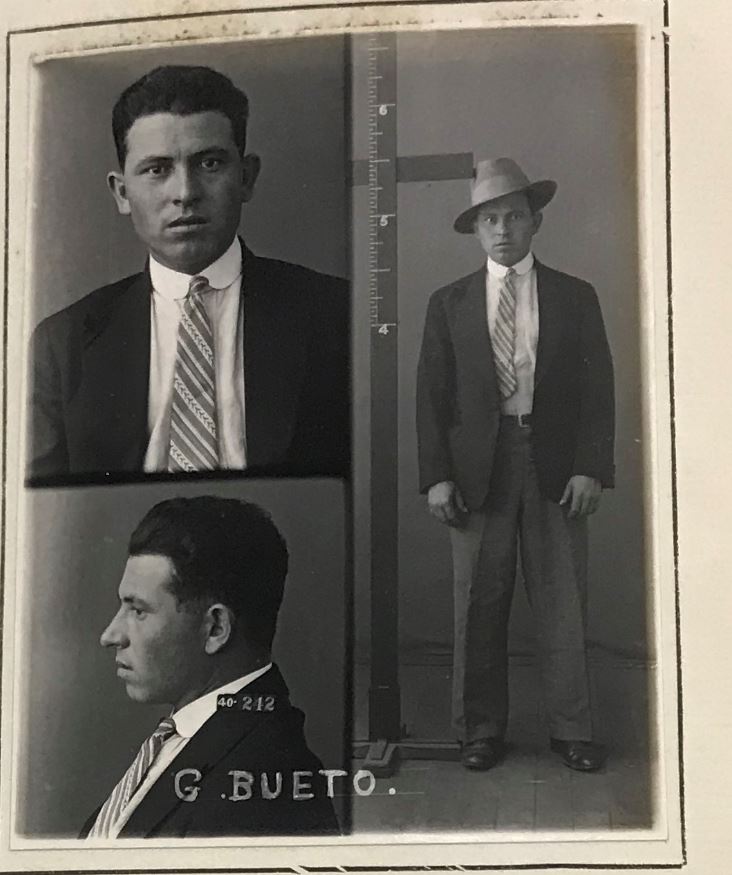
Native Place: America
Year of Birth: 1905
Arrival per ship: Pere De Italia 1923 from Italy
Trade: Hairdresser
Religion: Roman Catholic
Education: Read and Write
Height: 5ft 2½ inches
Weight: 10st 1lbs
Hair: Black
Eyes: Brown
Complexion: Dark
Build: Stout
Marks or Features: Scar across right wrist
Criminal History
Tried at Innisfail Police Court 3/10/1933 For having an Unlicensed pistol in possession Sentence- £50 or 3 months
Tried at the Cairns Circuit Court 9/4/1934 for Unlawfully wounding with intent to disfigure Sentence- 7 years Hard Labour.
Deported per ship Esqualina 1934 (no date) for Penal Island Lipari off Sicily (known as Devils Island)
Executed for being a British spy during World War 2
At this point in history, Italy was being governed by notorious dictator Benito Mussolini. Mussolini was a passionate believer in the prevention of embarrassment and disrepute of the mother land Italy. Anyone who did so would feel his wrath. Prisoners at home and abroad were sentenced to the notorious Devils Island a penal establishment located on the island of Lipari off Sicily. This island was a death sentence, prisoners rarely survived. It was a sentence for life… or until Mussolini saw fit to release you… which was never. However at the time the Italian army were waging a bitter war in Ethiopia, East Africa in the Abyssinian desert. Prisoners from Devils Island were used as cannon fodder in this war.
At the same time, prisoners in the Commonwealth of Australia that were foreigners and that were sentenced to serious crimes were deported from our shores. This particularly was the case in Queensland where the death penalty had been repealed just a decade earlier. The four Italian men locked up in Boggo Road Gaol would be no different. However, when the decision was made to deport these men, a problem arose. The government did not want to be held responsible for any ill will held between Iacona, Zucco, Parisi and Buete. Obviously there was ill – will given their situation. The authorities were worried there would be another murder on the way home to Italy. The men were sent home on separate ships. Iacona and Zucco on the Viminale and Parisi and Buete on the Esqualina.
So it was, Iacona, Parisi, Buete and Zucco were all deported back home to Italy. Back home to Devils Island. Back home to war in the Ethiopian Desert.
The fate of Iacona and Zucco is not known. It is presumed that they perished in the battle for the Abyssinian Desert. Parisi and Buete however would share very different fates. Parisi would survive the war in the desert, he would make it back home and see the death of Mussolini himself, eventually Parisi would return to Australia settling in Adelaide in the late 1940s. Buete was not so lucky. He was executed for being a British Spy and espionage during World War Two he was shot in the head and buried in an unmarked grave.
The Black Hand in Queensland is still known to this day, in fact, people in the area that these events took place still will not discuss it to this day. It is likely that there are still descendants of some of the families involved in the horrible crimes of the Black Hand.
We will have to discuss the Black Hand more in future episodes of Boggo. There are so many fascinating stories of murder and mayhem in the cane farms of North Queensland. But for now, be sure to listen to S2 Episode 10 of BOGGO – The Black Hand and hear all about these notorious figures.
Join Gaol Director Jack Sim and Research Co-ordinator Sue Olsen as they dig into the secrets of The Black Hand in Queensland, uncovering its connection to the notorious Boggo Road Gaol. Listen to the episode on the Black Hand S2 E10 of BOGGO – the official podcast of Boggo Road Gaol recorded live inside its walls. You can see for yourself where these underworld figures were locked up, tours operate of number 2 division daily at 11am for tour times and prices visit our website
The Colossus of Boggo Road
- On : 28 March, 2019
- By : Coordinator
- Category : Stories
- View : 5292
The Colossus of Boggo Road
Gold Coast bodybuilder Nathan Jones, at 207 centimeters and weighing 128 kilograms, was nicknamed “The Colossus of Boggo Road”.
The Colossus of Boggo Road in the movie “The Condemned”
Nathan was convicted in the Brisbane Supreme Court in April 1989 on five counts of attempted robbery and three of the unlawful use of a motor vehicle.
His eight-year sentence was increased to 12 years after an appeal by the Attorney-General.
In prison, an upset Nathan is said to have torn his cell door off; in reality he was a gentle giant.
Nathan was transferred when Brisbane Correctional Centre closed in 1992.
After serving his time, Nathan had a successful wrestling and movie career – including roles in blockbusters Troy, Mad Max: Fury Road, and horror films, Charlie’s Farm and The Condemned – filmed inside No.2 Division.
“TRIPOD” The Prison Cat
- On : 28 March, 2019
- By : Coordinator
- Category : Stories
- View : 4605
“TRIPOD” The Prison Cat
One of the last occupants of No.2 Division was “Tripod” – a much loved three-legged black tomcat.
“TRIPOD” the prison cat: photograph
taken 5th March 1988.
Source: Courier-Mail Library
His front left leg was badly broken during riots when it was caught in a cell door. Prisoners raised the money to have it amputated.
Prisoners jokingly referred to him as a “lifer” after 16 years of being in Boggo Road Gaol…
The Courier-Mail newspaper ran a story in March 1988 about Tripod:
“Most people consider black cats to be unlucky. But one group of people who have more reason than most to claim they are always down on their luck believe their black cat, Tripod is their good luck charm. Tripod is the mascot of the inmates of the notorious Division II wing of Brisbane Jail. Tripod, so named because he has only three legs, is jokingly referred to as a “lifer” around the jail as he has been there for 16 years.
He lost his left front leg when a cell door was slammed on it during a prison riot about 15 years ago. As a “registered” member of the prison establishment, Tripod gets his own ration of cat food each day before settling down in the main yard of Division II to keep an eye on things. When caught up with by photographer Graham Hutton, Tripod showed his displeasure at having his afternoon siesta disturbed by completely ignoring a visiting media group in the background.“
There has even been unconfirmed reports from some former prisoners that Tripod got a little angry towards the end of his life, and as a result, some prisoners put out a contract on Tripod’s life!
When his ‘9th life’ ran out Tripod was buried in a garden bed in No.2 Division where he remains to this day.
We have a special offer for these April, 2019 school holidays – all kids get a free Tripod the Boggo Road Cat poster with every family booking…
CLICK HERE TO BOOK FAMILY TICKET
(to get the poster, please make sure to select “Newsletter” when checking out under the “How did you find out about our tours?” question)
BOGGO S2 E9 – Workshops 90th Anniversary
- On : 28 March, 2019
- By : Boggo Road Gaol
- Category : Stories
- View : 3503
BOGGO S2 E9 – PRISON WORKSHOPS – The 90th Anniversary
With the closure of St Helena Island as a prison in Queensland came the shift of long service men to Boggo Road Gaol. What would now be the new number two division, the former prison for females would be moved elsewhere. The workshops for women were converted into the workshops for men. Soon however the need for the transfer of workshops from St Helena would necessitate the construction of an all new workshops at Boggo Road Gaol. 2019 marks the 90th Anniversary of these workshops.
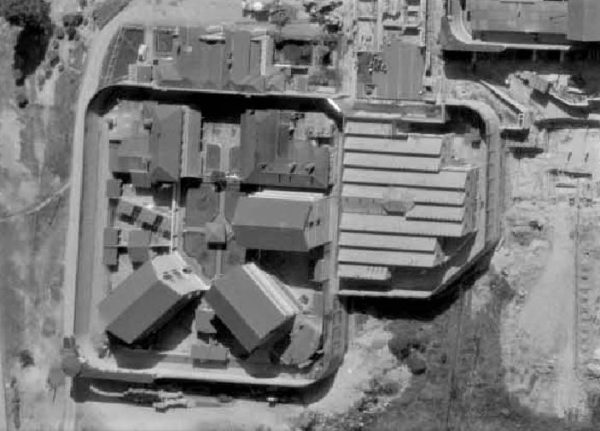
After more than 50 years of operation, HM Prison St Helena would become a prison farm. Male prisoners classified as long term were transferred to the mainland to Boggo Road. Increasing costs to transport prisoners and supplies across Moreton Bay, and growing public resentment of a perceived “island paradise” being utilised by convicted felons, were behind the decision to wind down St Helena.
H.M Gaol Brisbane became H.M Prison Brisbane, more commonly called Brisbane Prison. To accommodate the changes on 21st September, Brisbane Prison was re-organised into three separate sections – No.1 Division, No. 2 Division and a Female Division.
No. 1 Division
The 1883 Men’s Gaol was renamed No.1 Division. The wording “BRISBANE PRISON NO. 1” was added to the parapet. Inside its walls there were few other changes. In practise it continued to be the section used to hold short-term sentenced male prisoners, and those on remand awaiting trial or sentence, just as it had for decades. The yards were used to separate prisoners according to their classification.
Female Division
In September 1921 the few female prisoners were transferred from their purpose built prison into two wooden communal wards surrounded by a tall timber stockade. The ward buildings – the former V.D. hospital from Brisbane General Hospital had been moved from the Brisbane Hospital and erected to the south of the former Women’s Prison on Annerley Road. Ironically, not even 20 years after the prison designed to prevent the evils of association opened, women were again housed communally. This would remain the women’s prison for the next 30 years.
No. 2 Division
The former Women’s Prison was empties of its occupants as prisoners from the Men’s Gaol set about making alterations in preparations for the arrival of new occupants – long term sentenced men from St. Helena including, murderers, killers and other dangerous offenders.
Officially renamed No. 2 Division, the words on the parapet were amended from “H.M. PRISON FOR WOMEN” to “H.M. PRISON FOR MEN” the letters “WO” neatly covered to indicate the new use. This alteration can still be seen today. Beneath these words “No.2” was painted. Inside the gatehouse, on the rear wall prisoners painted “B.P” for Brisbane Prison on the left hand side and “No.2” on the right.
The two female wards were reused as cell blocks for men with 40 cells available in each block, No.2 Division could hold up to 80 male prisoners.
The design of No. 2 Division – permitting single cell accommodation and prisoners and having yards to separate prisoners, would allow the separation of male prisoners according to their classification, which had proved difficult to administer on St. Helena. There, some men were kept in associated wards “herded” together; minor offenders missed with experienced criminal; Promiscuous association” – sexual predation and homosexuality – were serious offences at the time. At St. Helena, communal accommodation had led to sexual assaults. Authorities hoped that sexual liaisons and crime could be limited in No.2 Division by walls, iron bars and doors.
The Workshop for Men (1921 – 1929)
Central to the new prison system was providing prisoners with meaningful work.
Tailoring and boot making were transferred in 1921 from St Helena to the former female workshop in No. 2 Division; the facilities were upgraded. In April 1924, Tin-smithing was also transferred to No. 2 Division. As had been the case for decades, tailoring, boot-making and tin-smithing would be carried out under the supervision of trade instructors – warders with skills in these areas. Long-term prisoners would be well-suited to learn a trade as they had the time to become proficient and would leave with a usable skill. Short-term prisoners carried out work that required less skill- brush-making, mat-weaving and basket-making.
NEW WORKSHOPS AND TUNNEL (1929)
Until early 1929, male prisoners continued to be employed in the former women’s prison workshop in No.2 Division. On the 26th March a vast new saw-tooth roofed industrial complex opened, behind the eastern wall of the division. Encircling the “workshops” was a six metre high brick wall. A significant security feature was a central security tower – D Tower- manned by an armed officer. Mirrors high on the walls allowed the officer to see into every shop at all times. An underground tunnel – connecting No. 1 Division and No. 2 Division was built, allowing prisoners to be moved to and from the new workshop complex.
The workshops included a tailor shop – producing staff and prisoner uniform; boot shop – making boots worn by prisoners, mat-shop – making mats, mattresses ad hammocks; brush-shop – brushes and brooms; hat shop – hats worn by prisoners; bookbinding.
A new carpenter’s shop was dedicated to woodwork – to manufacture articles needed in government institutions such as schools. In May 1930 a new warder- carpenter was employed to teach that trade to prisoners.
After the opening of the new workshops the old female workshops was converted into an additional cell block to cope with the expected increase in prison population.
In this episode of BOGGO, Gaol Director Jack Sim and Research Coordinator discuss the Workshops, the cost of their construction and some of their interesting features as well as their crucial role in everyday prison life. Tune in to BOGGO the official podcast of Boggo Road Gaol to hear more.
You can stand in the former female workshops now D Wing cell block every day on our History Tour for tour times and prices visit www.boggoroadgaol.com


